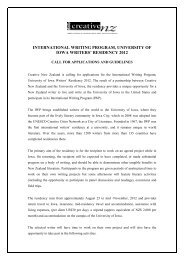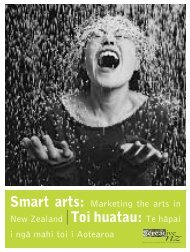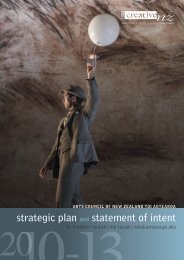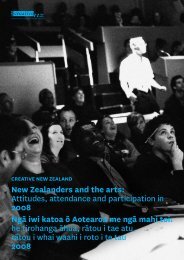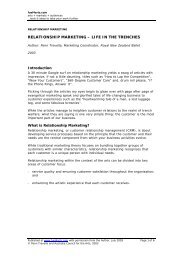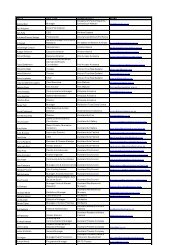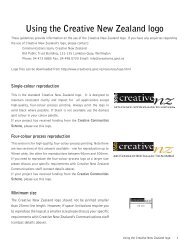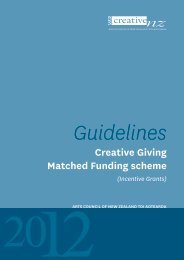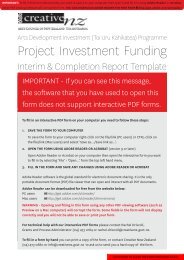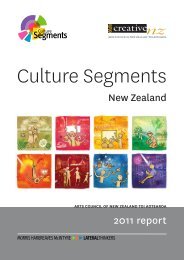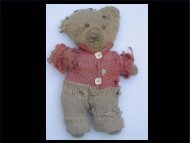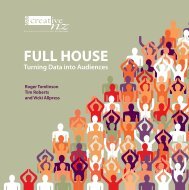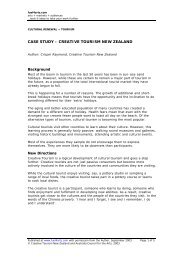Download PDF 626 KB - Creative New Zealand
Download PDF 626 KB - Creative New Zealand
Download PDF 626 KB - Creative New Zealand
You also want an ePaper? Increase the reach of your titles
YUMPU automatically turns print PDFs into web optimized ePapers that Google loves.
“Audiences”, he noted, “demonstrate their engagement through a range of responses – both<br />
positively and negatively”. Participation and engagement are at the heart of what art does.<br />
The challenge to arts practitioners is to break down barriers to engagement in the arts, to<br />
work so that the gap between audience and artist is no longer a mysterious divide, and to<br />
make experiences we create as artists and arts managers so engaging that “these<br />
experiences are as commonplace as going to the supermarket”.<br />
A short video from Andrew McIntyre (Morris Hargreaves McIntyre) discussed the themes<br />
canvassed in the conference reader: the importance of cultural experiences emphasising<br />
interaction as the way people engage with culture changes; the explosion in digital<br />
technology; the challenges of dwindling younger audiences; and the current lively debate<br />
about how we should relate to audiences.<br />
Interaction, personalisation and co-creation are all part of the spectrum of audience<br />
engagement. But growth of and interest in interactivity is not new. Artists and audiences<br />
have interacted for centuries. “Twitter didn’t invent word of mouth” and audiences were<br />
responding vociferously to theatre when Shakespeare was alive.<br />
We’re told there is a “pro-am revolution” and that technology and the internet have<br />
accelerated the move towards co-creation in the arts. “But is it true?” McIntyre questioned.<br />
Will audience of the future stop wanting to consume art and only want to co-create?<br />
“Interactivity is a powerful way to engage people in the arts, but it is not the only way.”<br />
The arts can reach every human being and satisfy myriad human needs (intellectual, social,<br />
emotional/aesthetic, spiritual) in myriad ways. Arts audiences are sophisticated, eclectic and<br />
diverse. Interactivity and co-creation haven’t stopped people from losing themselves in a<br />
favourite painting, or having the hairs on the back of their neck stand up when they hear a<br />
particular piece of music. While personalisation is non-negotiable, interactivity should be<br />
approached in a way that fits your artistic vision. And whatever you do, says McIntyre, you<br />
should be relentlessly audience focused.<br />
Welcome Keynote Address<br />
Stephen Wainwright, Chief Executive <strong>Creative</strong> <strong>New</strong> <strong>Zealand</strong><br />
The 21 st Century Arts Conference, noted Stephen Wainwright, offers the arts community a<br />
chance for reflection.<br />
“We are still a young society”, he noted – “and one where the arts have not had the role they<br />
may have played in longer-established societies”. He used his own up-bringing as an<br />
illustration of how far removed many <strong>New</strong> <strong>Zealand</strong>ers were from creative experiences as<br />
they grew up in the ’50s and ’60s.<br />
Rugby racing and beer dominated our national psyche, and in most families, often headed<br />
by tradespeople, no one attended university. Mothers stayed at home, and formal education<br />
(as little as a generation or two ago) ended with primary school. It’s only a generation or two<br />
back that any boy who didn’t play rugby was labelled a sook or worse, and there is an<br />
“ongoing suspicion in this country of the effete, the intellect and the ‘arty’.”<br />
At the same time, society is underpinned by the <strong>New</strong> <strong>Zealand</strong> ideal of “fairness” and a work<br />
ethic stemming from the Puritan roots of the early settlers. For Pakeha boys at least, recalled



